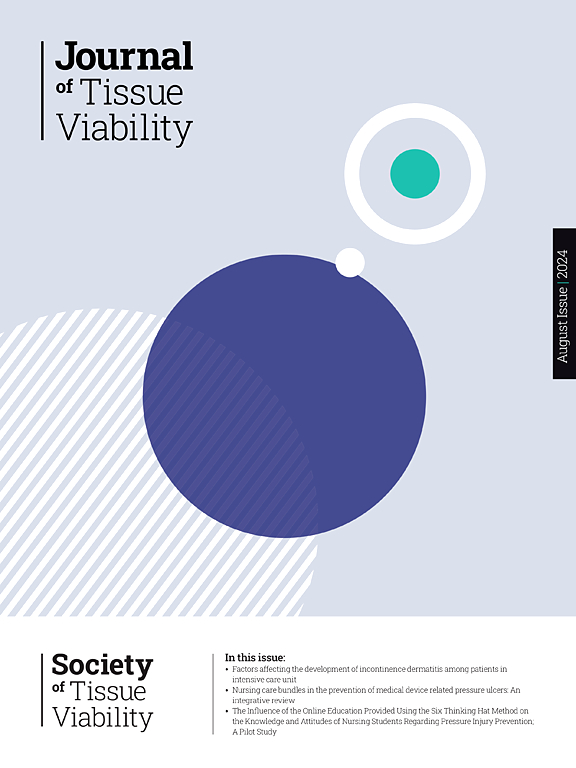机器学习对糖尿病足溃疡预测的影响--系统综述。
IF 2.4
3区 医学
Q2 DERMATOLOGY
引用次数: 0
摘要
导言:在全球范围内,糖尿病及其相关并发症,如糖尿病足溃疡(DFUs),构成了重大的健康挑战。早期发现糖尿病足溃疡对治疗过程非常重要,而机器学习或许能在治疗过程中为临床人员提供帮助:通过 Cochrane 图书馆、MEDLINE (OVID)、EMBASE、CINAHL Plus 和 Scopus 数据库,对过去十年内发表的英文报告进行了 PRISMA 信息检索。主要研究结果是机器学习对 DFU 预测的影响。次要结果是报告的统计性能指标。使用预先设计的数据提取工具提取数据。采用循证图书馆学关键评估工具进行质量评估:共有 18 篇报告符合纳入标准。九份报告提出了识别健康皮肤或 DFU 两类皮肤的模型。九篇报告提出了预测 DFU 进展的模型,例如将感染与非感染进行分类,或利用伤口特征预测愈合情况。报告提出了多种机器学习技术。在报告中,灵敏度 = 74.53-98 %,准确度 = 64.6-99.32 %,精确度 = 62.9-99 %,F 值 = 52.05-99.0 %:研究人员提出了多种机器学习模型,以成功地将 DFU 从健康皮肤中分类,或为 DFU 的预测提供信息。所提出的机器学习模型有可能为管理 DFU 的临床实践提供信息,并有助于改善 DFU 患者的治疗效果。未来的研究可能会受益于检测、诊断和预测 DFU 进展的标准设备和算法的开发。本文章由计算机程序翻译,如有差异,请以英文原文为准。
The impact of machine learning on the prediction of diabetic foot ulcers – A systematic review
Introduction
Globally, diabetes mellitus poses a significant health challenge as well as the associated complications of diabetes, such as diabetic foot ulcers (DFUs). The early detection of DFUs is important in the healing process and machine learning may be able to help inform clinical staff during the treatment process.
Methods
A PRISMA-informed search of the literature was completed via the Cochrane Library and MEDLINE (OVID), EMBASE, CINAHL Plus and Scopus databases for reports published in English and in the last ten years. The primary outcome of interest was the impact of machine learning on the prediction of DFUs. The secondary outcome was the statistical performance measures reported. Data were extracted using a predesigned data extraction tool. Quality appraisal was undertaken using the evidence-based librarianship critical appraisal tool.
Results
A total of 18 reports met the inclusion criteria. Nine reports proposed models to identify two classes, either healthy skin or a DFU. Nine reports proposed models to predict the progress of DFUs, for example, classing infection versus non-infection, or using wound characteristics to predict healing. A variety of machine learning techniques were proposed. Where reported, sensitivity = 74.53–98 %, accuracy = 64.6–99.32 %, precision = 62.9–99 %, and the F-measure = 52.05–99.0 %.
Conclusions
A variety of machine learning models were suggested to successfully classify DFUs from healthy skin, or to inform the prediction of DFUs. The proposed machine learning models may have the potential to inform the clinical practice of managing DFUs and may help to improve outcomes for individuals with DFUs. Future research may benefit from the development of a standard device and algorithm that detects, diagnoses and predicts the progress of DFUs.
求助全文
通过发布文献求助,成功后即可免费获取论文全文。
去求助
来源期刊

Journal of tissue viability
DERMATOLOGY-NURSING
CiteScore
3.80
自引率
16.00%
发文量
110
审稿时长
>12 weeks
期刊介绍:
The Journal of Tissue Viability is the official publication of the Tissue Viability Society and is a quarterly journal concerned with all aspects of the occurrence and treatment of wounds, ulcers and pressure sores including patient care, pain, nutrition, wound healing, research, prevention, mobility, social problems and management.
The Journal particularly encourages papers covering skin and skin wounds but will consider articles that discuss injury in any tissue. Articles that stress the multi-professional nature of tissue viability are especially welcome. We seek to encourage new authors as well as well-established contributors to the field - one aim of the journal is to enable all participants in tissue viability to share information with colleagues.
 求助内容:
求助内容: 应助结果提醒方式:
应助结果提醒方式:


